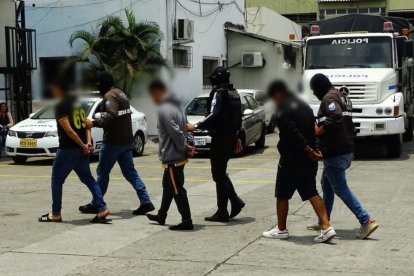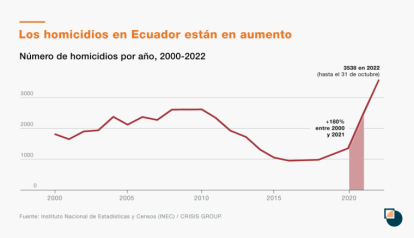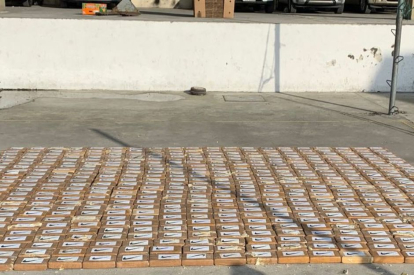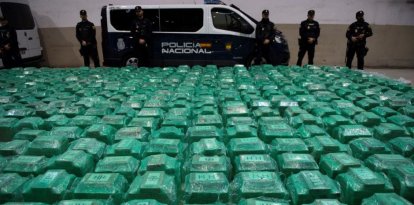"Ecuadexico": drug violence pulls Ecuador down Mexico's road
The Andean country went from being a transit point to producing and refining its own illicit merchandise for sale in the United States and Europe.

(@CmdtPoliciaEc / Twitter)
Three heads, one of a teenager, are found in black bags in the middle of the street. A security guard goes to the police with explosives taped to his abdomen because, allegedly, the owner of the jewelry store where he worked had refused to pay a bribe. Two hitmen assassinate a mayoral candidate the night before the election.
These are not scenes from Narcos, Netflix's series that dramatizes the story of Colombian drug trafficker Pablo Escobar. Neither from Narcos: Mexico, the sequel that chronicles the illegal drug trade in the North American country. They are all from the here and now, Ecuador 2023.
Better known for its biodiversity, its fruit exports - especially bananas - and its Panama hats (originating in Ecuador, not Panama), violence has become part of the daily life of Ecuadorians in recent years.
So much so, that the government authorized civilians to carry firearms and aerosols for self-defense. The measure, announced by President Guillermo Lasso earlier this month, also allows private security employees to assist public forces in surveillance tasks. The increase in killings even led to the resignation of the Secretary of Security, Diego Ordóñez, after some thirty gunmen shot at merchants and fishermen in the port city of Esmeraldas.
Historical homicide record
Last year was especially bloody for Ecuador: the homicide rate rose 82.5% from 2021 to 2022, according to an analysis by the specialized website Firsts. This makes it the highest figure in its history, and would also make it the country where violence grew the most in the entire region.

International Crisis Group chart showing the growth of homicides in Ecuador.
The White House includes Ecuador on its annual list of "major drug transit or major illicit drug producing countries." The document states that drug trafficking resulted in more than 100,000 addiction and overdose deaths in the United States in 2021. This is also one of Americans' top public health concerns, according to a recent Axios poll.
"Though Ecuador has seen killing sprees before, it previously had no notable history of either guerrilla or cartel activity; in recent years, it has also been seen as one of the safer countries in Latin America," says the report, "The wave of drug trafficking violence in Ecuador" by the International Crisis Group.
The independent organization's report argues that criminal organizations based in Colombia and Mexico are behind the growth of drug gangs in Ecuador. The former "subcontract" part of their supply chain to Ecuadorian groups:
Thus, the Andean nation went from being a transit country - for which it has ideal conditions such as its ample access to the sea and its border with producer countries Colombia and Peru - to producing, refining, storing and distributing its own merchandise.

Drug packages seized by the Ecuadorian Police.
Made in Ecuador
The booming drug business fostered the growth of local criminal groups. They went from being "subcontractors" for foreign organizations to "prison and drug trafficking gangs that have vastly grown in sophistication and size in recent years," according to analysis by think tank, InSight Crime.
According to InSight Crime, Los Choneros are the biggest gang in the country. It would have started as the armed wing of a Colombian cartel that dominated the maritime trafficking route to North America. Over time, it grew and located itself in several cities and penitentiaries and soon became "Ecuador's most formidable prision gang."
Another important group -and enemy of the previous one- is Lagartos. Clashes between the two "have come to define the violence in Ecuador," although according to the think tank, their importance may have declined in recent years in favor of newer gangs. These criminal groups also form alliances, such as the Cartel Nueva Generación Ecuador (Ecuador New Generation Cartel, in English), which brings together Los Lobos, the Tiguerones and the Chone Killers.
Prisons: recruits, 'capos' and massacres
"Prisons in Ecuador are often controlled by criminal organizations," Human Rights Watch concluded in a July 2022 report.
Prisons also serve as a center of operations. In the words of Human Rights Watch:
This was the case of Dritan Rexhepi, who from his prison cell ran an Albanian criminal gang that brought millions of euros of cocaine to Europe, according to an investigation by the Balkan Investigative Reporting Network.
Not only are recruiting and organizing frequent in prisions, murder is also common currency. And now on the rise: in 2018 there were 15 murders reported in Ecuadorian prisons, in 2021, that number climbed to 348. These numbers come from an analysis by the Permanent Committee for the Defense of Human Rights that combines official data with press reports.
In total, the non-governmental organization recorded 591 murders from 2018 to 2022. Deaths in prison massacres also increased: 25 in 2020, 312 in 2021 and falling back to 121 in 2022. An overall tally of 458 in three years.
RECOMMENDATION





















